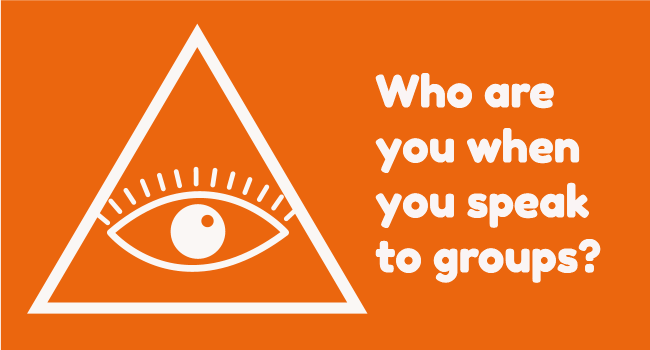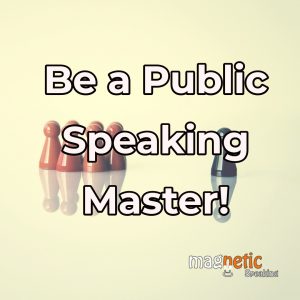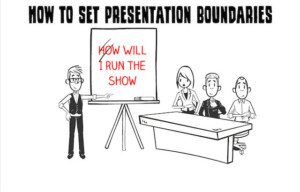How you see yourself (self identity) on the inside matters. It can mean the difference between you standing up with poise or you trembling with fear.
Imagine this:
I am standing on a stage with a 400 people staring back at me, my heart rate is ready to explode, my mouth is dry, my palms are sweaty, and I am wondering why is this happening to me?
No, I did not have a heart attack.
I had just left engineering and had been working as a professional speaker for a year and a half. Most of the time I felt comfortable speaking to groups, but occasionally and for some reason, I experienced extreme anxieties on stage.
As always, I managed to pull through that time and gave my keynote as if nothing happened, but I know I could not go on like this. I wanted more consistency with my performance.
While working with my public speaking coach trying to pinpoint the source of my speaking anxiety, I had a shocking realization. I realized that even though on the outside, I dressed, walked and spoke like a professional speaker, however, on the inside, I still saw myself as an engineer.
As a result, I felt like a pretender and fraud even though I know my material and knew that it benefited my audience.
At one of my session with the coach, I finally, grasped the power of the dominant personal identity. We all have one. Most of the time it’s the job position we hold.
What do you tell people when they ask you about what you do? You typically say “I am an engineer,” “I am a product manager,” “I am a director of R&D.” Right? That’s the identity you most likely put on when you do public speaking.
The dominant identity you chose for yourself helps you at the beginning of your career, however, the moment you decide to move to a different role or a bigger role, that same identity will hold you back.
Let’s say you want to go from engineering to sales; your engineering identity will panic right away. Your engineering identity will shout, kick and scream to keep you as an engineer. You will catch yourself saying, why am I doing this to myself? I am not good with people, why do I even want to go into sales. That’s normal. It means that your dominant identity is doing what it’s supposed to do.
And if you decide to move to sales despite your dominant identity, then you will most likely feel like a fraud or misfit. That will wreak havoc on your self-confidence.
Your identity has a self-protection mechanism, and it will always try to keep you from changing. There is nothing wrong with that unless you want to change and grow and move on from your current title and role.
While working with my coach, I decided to change my dominant identity from an engineer to a leader. Now don’t get me wrong the identity of an engineer will never leave me, It will just be a smaller identity next to the dominant leader identity. Once I adopted and nurtured the leader identity, I noticed a significant improvement in my public speaking confidence.
Should you choose the leader identity for yourself?
Although the leader identity is a great identity to have, you need to pick something that’s going to help you in your career, life, and public speaking confidence. For me what worked is the leader identity, for you, it might be something else.
To pick a suitable identity, you need to be in a state of full self-expression. Full self-expression means that fear, anxiety or stress are not obstacles. If you chose your identity while in a negative state, then your choice will be based on survival instead of thriving. You want your new inner identity to be based on a state of thriving.
Picking an identity has two stages:
1. Cultivating a thriving psychological state,
2. Selecting an identity that will help you thrive
Cultivating a thriving mental state:
One of my favorite ways to develop a thriving instead of surviving mental state is meditating over Maslow’s hierarchy of needs. You can do this by mentally walking yourself up to the hierarchy triangle before you create a speech, or tackle a problem, or write a blog article. In this article, I will show you how to use this before you choose a new dominant identity for yourself.
What is the Maslow hierarchy?
It a framework developed by Abraham Maslow in the 1940s to provide people with a blueprint to happiness and self-expression.
It starts at the bottom of the triangle with shelter and food, moves up to relationships and love, then to accomplishments, and then to full self-expression. It states that you can’t experience full self-expression without experiencing achievement first, and you can’t experience accomplishment without experiencing relationship first, and so on.
For example, if you don’t feel secure about your food and shelter, then you are in survival mode, and you will have a hard time being fully self-expressed. Survival is the lowest, and full self-expression is the highest.
How to use Maslow’s Hierarchy of needs to develop a thriving state and then select your dominant identity?
Use your imagination to climb the ladder all the way up to the self-expression phase, then from there you decide on your identity.
Here is a step by step method:
- Find a comfortable and quiet place
- Close your eyes and start imagining that you have all the food you need and safest shelter you could have.
>> I imagine walking in paradise with the most delicious fruits, meats, and international cuisine all around for me to sample and eat. I also imagine that I have multiple houses that are safe, furnished and available for me use and sleep. (Remember you are going to a state of mind, so you can use your imagination to trick your brain into achieving the state with visualization). - Imagine the relationships you want, i.e. spouse, boyfriend, girlfriend, best friends, family, etc. Feel their love and support and give them love and support back.
- Imagine that you have all money, all the recognition, all the awards you wish to earn and enjoy having them.
- Now imagine that you have everything else you need until you get to a point where you don’t need anything else.
- Out of this state of not needing anything decide on your dominant identity (realize that many small functional identities will fit under it like your current job identity).
Here are some identity choices from clients: Leader, innovator, creator, god, teacher, Buddha, authority figure, boss, etc.
You get the idea.
What is yours? Share it with the world in the comments below.
Once you chose an identity, it does not mean it’s set in stone. You can change and evolve anytime you wish using the same process. I had to go through many iterations until I got to the identity of a leader. I suspect that you will too. I even had a hard time doing the exercise initially, because my brain was always in a state of need and survival and it took many tries to get it to cooperate.
There are so many benefits to this exercise to your life, career, and finances that are beyond this article to discuss so please if you have questions ask them in the comment’s section below.
Conclusion
If you want to improve your speaking confidence and get rid of your speaking anxiety, you may wish to update your self-image and core identity. Your new identity has to be bigger than the identities you have right now, and it has to be based on full self-expression instead of fear, need, lack or survival.



